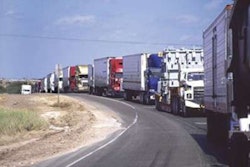Hosting all assets

Transportation companies increasingly are delivering mobile applications faster and more easily using the Software-as-a-Service (SaaS) or hosted model. At the forefront of this trend are carriers, brokers and logistics providers using noncompany assets and drivers to capture and manage shipment information.
Asset-based carriers that invest in mobile communications platforms have continuous load visibility to capture shipment information from drivers at pickups and deliveries. But nonasset logistics providers can have the same shipment tracking capabilities despite major differences in the technology used by their contracted drivers and vehicles.
Today, instead of requiring drivers to call periodically to report load status and other details, transportation companies simply have drivers download an application to a mobile handset – or perhaps just get drivers’ permission to track them.
AT&T has a new Location Information Services (LIS) offering that enables transportation companies to capture location information from drivers’ handsets, regardless of hardware or wireless service provider.
To use the service, a transportation company would get a driver’s permission to capture location data, and location information from a driver’s handset can be fed directly into dispatch and routing systems in the office, says John Moscatelli, director of AT&T’s transportation industry solutions practice. The new service uses LocationSmart, a technology developed by TechnoCom, to capture and aggregate location information from all major wireless carriers.
SaaS applications have become so common and easy to deploy that even a contract driver on his first trip for a logistics company can capture information as efficiently as a well-trained company driver.
Mobile applications can handle even the most difficult logistical situations.
This month, Cardinal Logistics is set to go live with Cardinal Activity Tracker (CAT), a new SaaS application that it developed specifically for its contractors. The Concord, N.C.-based 3PL and dedicated transportation provider has a fleet of 1,500 company trucks and 250 owner-operators.
The SaaS version of CAT extends the application from mobile computers to mobile devices with a “dynamic workflow” feature to simplify training. CAT presents drivers with specific instructions – based on customer profile – for capturing delivery exceptions.
If the first stop on a route is a grocery store, a button pops up asking the driver to enter the load’s temperature. If the next stop is a delivery of windows to a millwork factory, a new button pops up for the driver to scan the product and to record any exceptions.
“As we get more customers, it becomes more difficult for drivers to understand which exceptions are for which customer,” says Clay Holmes, chief information officer. “Now the exceptions show in workflow for every delivery receipt they have.”
Even the most difficult shipment tracking situations that a logistics provider encounters can be solved quickly with a mobile application. Consider a 3PL operation that transfers or “cross-docks” freight between origin and destination. A single shipment may involve multiple customers and carriers.
Airclic recently upgraded its Courier Perform product with a cross-dock feature that helps simplify operations. Freight can be scanned using virtually any mobile phone as it is taken from one truck and loaded onto the next. No matter how many times a product changes hands, managers know the location of their packages throughout the delivery process and can track orders down to the item level.
The latest software applications for mobile devices enable transportation companies to expand their technology resources quickly – and at minimum cost.
Aaron huff is Senior Editor of Commercial Carrier Journal.
E-mail [email protected] or call (801) 754-4296.










